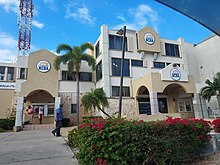 | |
| Currency | East Caribbean dollar (XCD) 1 US$ = 2.7 XCD (2014) |
|---|---|
| 1 April - 31 March | |
Trade organisations | OECS, CARICOM (associate) |
| Statistics | |
| GDP | -8.5% (2009 est.) |
GDP per capita | $12,200 (2008 est.) |
GDP by sector | agriculture: (2.6%) industry: (24.4%) services: (73%) (2014 est.) |
| 3.1% (2014 est.) | |
Population below poverty line | 23% (2002 est.) |
Labour force | 6,049 (2001 est.) |
Labour force by occupation | agriculture: 4%, industry: 21%, services: 75% (2000 est.) |
| Unemployment | 8% (2002 est.) |
Main industries | tourism, boat building, offshore financial services |
| External | |
| Exports | $11.7 million (2014 est.) [1] |
Export goods | lobster, fish, livestock, salt, concrete blocks, rum |
Main export partners | |
| Imports | $138.3 million (2014 est.) |
Import goods | fuels, foodstuffs, manufactures, chemicals, trucks, textiles |
Main import partners | |
| Public finances | |
| $8.8 million (1998) | |
| Economic aid | $9 million (2004) |
All values, unless otherwise stated, are in US dollars. | |
The economy of Anguilla depends heavily on luxury tourism, offshore banking, lobster fishing, and remittances from emigrants. Due to its small size, few natural resources, and reliance on tourism and foreign direct investment, Anguilla is vulnerable to external economic conditions in the United States, Canada and Europe. Therefore, economic growth in Anguilla can be very volatile. Anguilla's currency is the East Caribbean dollar, though the US dollar is also widely accepted.[2] The exchange rate is fixed to the US dollar at US$1 = EC$2.70.
- ^ "CIA – The World Factbook". Cia.gov. Retrieved 2015-06-30.
- ^ "Encyclopedia Britannica – Anguilla". Retrieved 12 July 2019.
© MMXXIII Rich X Search. We shall prevail. All rights reserved. Rich X Search
